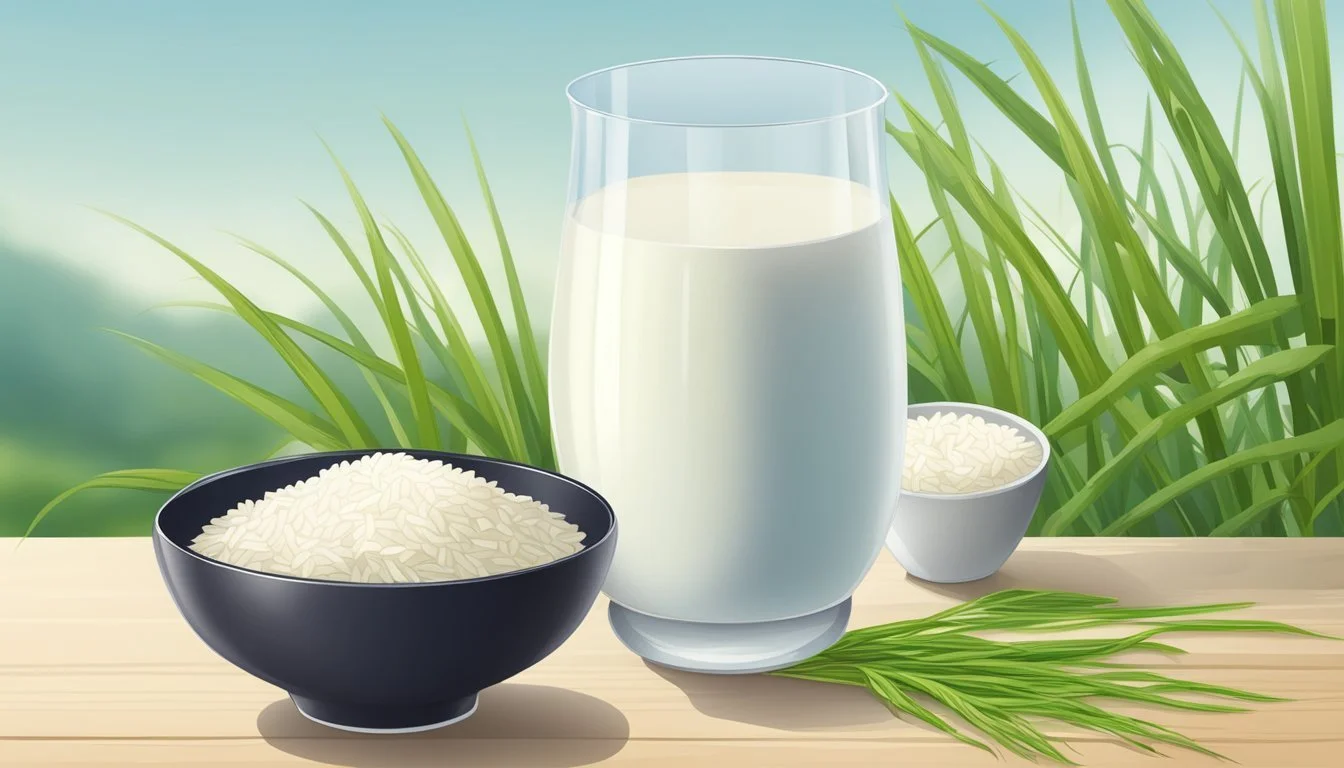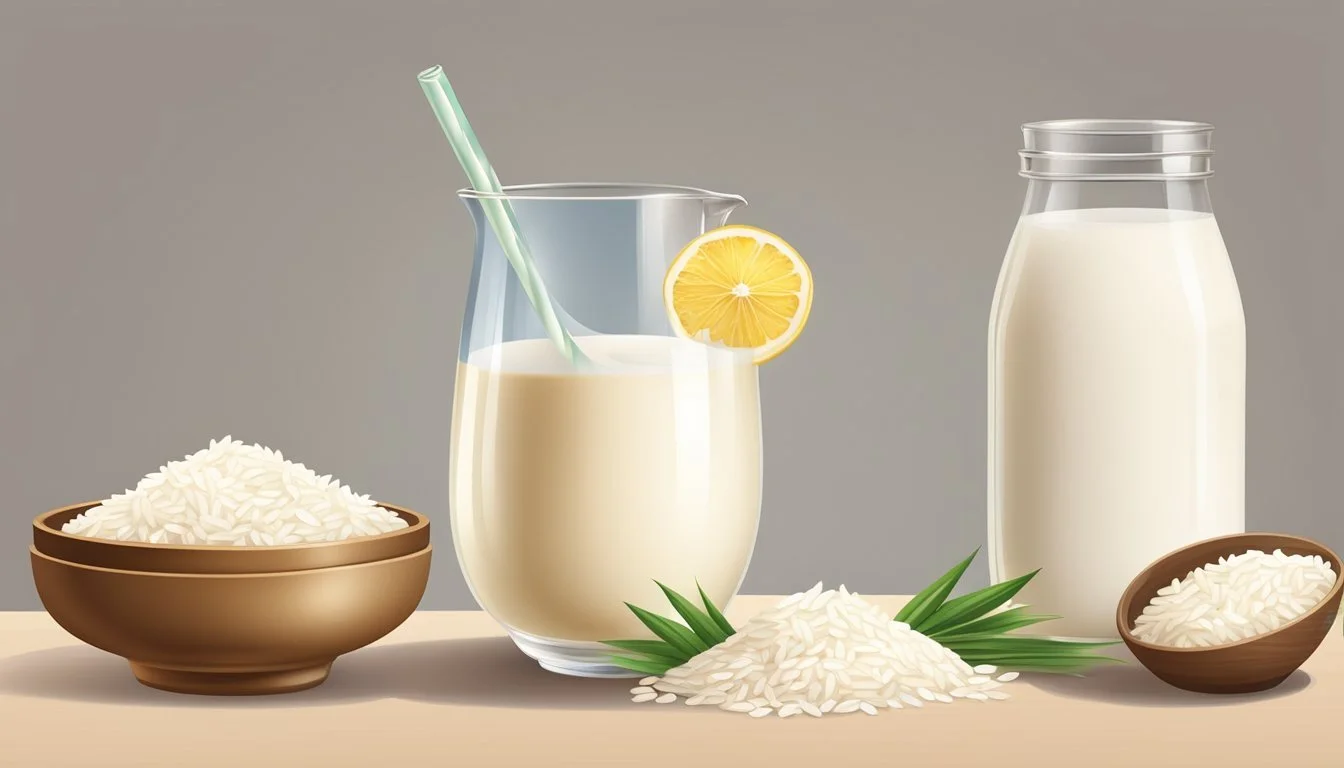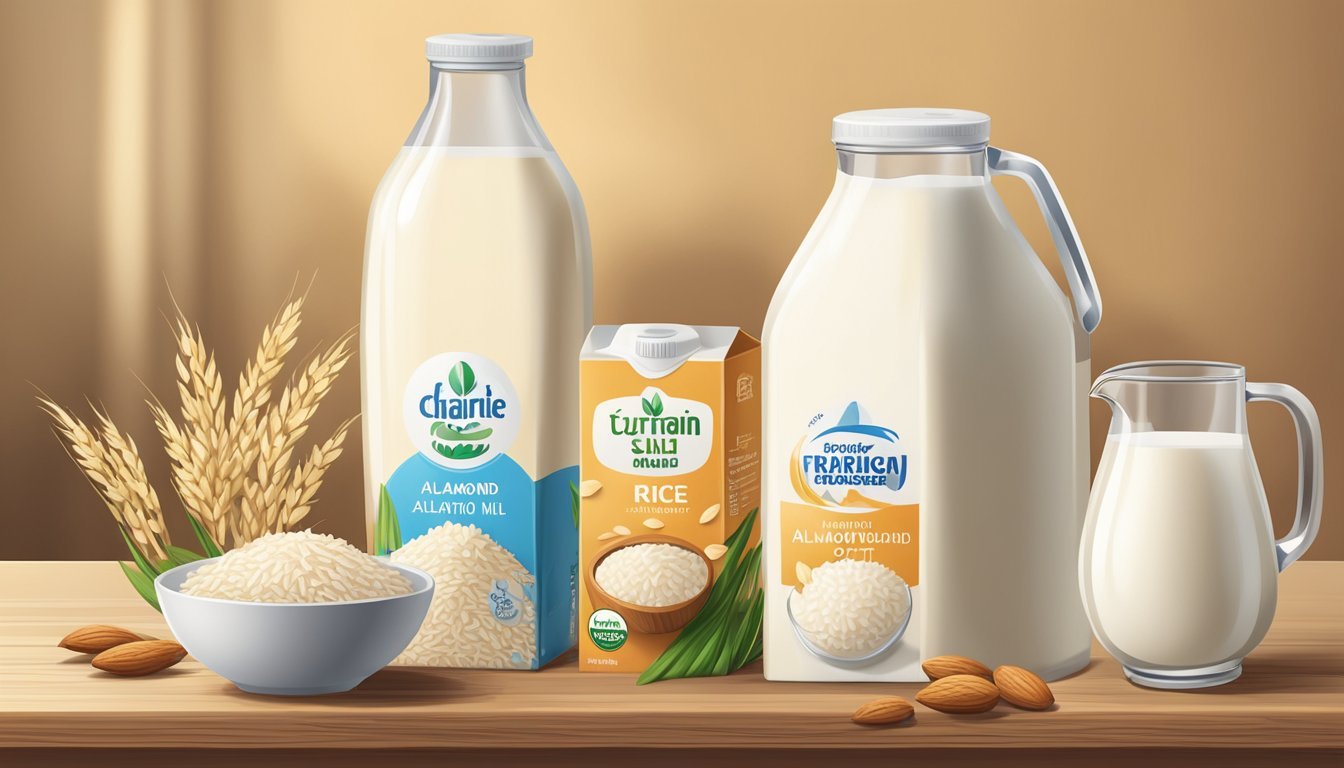Rice Milk Substitutes
Top Dairy-Free Alternatives Explored
Rice (What wine goes well with rice?) milk is a plant-based milk alternative that has gained popularity among those with lactose intolerance and individuals seeking dairy-free options. Its light consistency and naturally sweet taste make it a suitable dairy milk substitute for cereals, beverages, and in cooking. However, individuals may seek alternatives to rice milk due to dietary preferences, nutritional considerations, or simply for variety in flavor and texture.
As the demand for plant-based milk alternatives expands, a diverse array of options has emerged, each with unique nutritional profiles and flavors. Almond milk, often praised for its low-calorie content and abundance of vitamin E, is an excellent option for a mild, nutty flavor. Oat milk, characterized by its creamier texture and higher fiber content, caters to those looking for a more filling alternative. Soy milk stands out as a protein-rich option, closely mimicking the protein levels found in cow's milk and making it a staple among dairy alternatives.
Beyond the more common selections, the market offers an even broader spectrum of milk substitutes including coconut milk, hemp milk, and walnut milk. Each of these offers distinct nutritional benefits, such as the omega-3 fatty acids present in walnut milk, and can be used in a variety of culinary applications. For individuals with specific health goals or dietary restrictions, the variety of available plant-based milk alternatives ensures there is a suitable option for almost every preference and need.
Understanding Rice Milk
Rice milk is a plant-based milk alternative derived from milled rice and water. It provides a different nutritional profile than dairy milk and has distinctive uses and characteristics that cater to various dietary needs.
Nutritional Profile
Rice milk typically offers a low protein content compared to cow's milk and other milk substitutes. It is high in carbohydrates, and most brands enrich their rice milk with calcium and vitamin D to bring it closer to the nutritional value of dairy milk. However, it is naturally low in fat, which makes it a light option for consumers.
Protein: Generally low
Fat: Low content
Carbohydrates: Comparatively high
Calcium: Often enriched
Vitamin D: Usually enriched
Vitamins and Minerals: Can vary based on fortification
Common Uses in Diet
Rice milk's sweetness and light consistency make it favorable for both drinking and culinary applications, such as in coffee or smoothies. Its subtle flavor and texture make it a versatile ingredient for recipes that require a liquid addition without a heavy creamy taste or feel.
Pros and Cons
Pros of rice milk include its suitability for individuals with lactose intolerance, dairy allergy, or those following a low-fat diet. It is also a good option for those who prefer a milk substitute that's less creamy and closer to the consistency of rice milk. However, due to its higher carbohydrate content and lower protein levels, it may not be the preferred choice for everyone, especially those seeking a protein-rich alternative or managing carbohydrate intake for health reasons such as diabetes.
Health Considerations for Milk Substitutes
When selecting a milk substitute, it's imperative to consider allergy compatibility, the nutritional benefits provided, and how the substitute aligns with specific dietary restrictions. A thorough understanding of these health considerations can guide consumers to the best choice for their dietary needs.
Allergy and Intolerance
Allergies: People with allergies to nuts or soy should avoid milk substitutes derived from these sources, such as almond, cashew, and soy milk. Oat milk and rice milk can be suitable alternatives as they are generally hypoallergenic.
Lactose Intolerance: Those who are lactose intolerant can benefit from plant-based milk alternatives, which are naturally lactose-free, offering a digestive advantage over cow’s milk.
Nutritional Benefits
Protein Content: Soy milk typically contains a higher protein content compared to other milk alternatives, making it beneficial for those seeking to increase their protein intake.
Healthy Fats: Substitutes such as hemp milk offer a source of healthy omega-3 fatty acids, which are important for heart health.
Benefits: Many milk alternatives are enriched with vitamins and minerals, such as vitamin E found in almond milk, which contributes to a strong antioxidant profile.
Dietary Restrictions
Dietary Needs: Vegan and vegetarian individuals can find ample options among plant-based milk substitutes to meet their dietary lifestyle. Nut and soy-based milks are commonly vegan-friendly.
Heart Health: Heart-healthy options include milk substitutes low in saturated fats, and some like almond milk may also contribute to lower cholesterol levels due to their healthy fat content.
Dietary Restrictions: Those with specific dietary restrictions should check labels for added sugars and other additives that might not align with their nutritional goals, to ensure they choose the most suitable milk alternative.
Plant-Based Milk Varieties
The diversity of plant-based milk options caters to various dietary preferences and uses in the kitchen. From nuts and grains to seeds and legumes, each category offers unique nutritional profiles and flavors suited for different culinary applications.
Nut Milks
Almond milk: A popular choice for its light texture and nutty taste, it provides a good source of vitamin E and is low in calories. Almond milk works well as a dairy substitute in both sweet and savory dishes.
Cashew milk: Known for its creaminess, cashew milk enriches coffee, smoothies, and soups. It's also rich in vitamins and minerals, including iron and magnesium.
Grain Milks
Oat milk: Valued for its fiber content and naturally sweet flavor, oat milk excels in baking and as a breakfast cereal companion. It's also environmentally friendly, requiring less water to produce than nut milks.
Quinoa milk: Made from a protein-packed ancient grain, quinoa milk contains all nine essential amino acids, setting it apart from most plant milks. It offers a slightly nutty flavor and a rich, nutritious addition to any diet.
Seed Milks
Hemp milk: Less creamy than nut milks, hemp milk is derived from hemp seeds and supplies a wealth of omega-3 and omega-6 fatty acids. Its earthy taste can be an acquired preference.
Legume Milks
Soy milk: A staple in plant-based milks, soy milk is a complete protein source and a versatile dairy alternative. It provides a balanced taste and can be used in a variety of recipes.
Pea milk: Pea milk is one of the newer entries in the plant-based scene, boasting a high-protein content with a lower environmental impact. It offers a neutral flavor that doesn't overpower other ingredients in dishes.
Factors Influencing Choice of Milk Substitutes
When considering milk substitutes, consumers often weigh their options based on taste preferences, nutritional content, and how well these alternatives perform in cooking and baking.
Taste and Texture Preferences
Consumers' personal taste and texture preferences play a significant role in their choice of milk substitutes. Rice milk typically offers a mild flavor and thin consistency, suitable for those who prefer a subtler taste. On the other hand, alternatives such as almond milk deliver a nutty flavor and are often chosen by those seeking a milk with a distinct taste. Oat milk is known for its creamy texture, making it a favorite for smoothies and coffee. Soy milk, with a more neutral profile, is versatile across various culinary applications.
Nutritional Content Comparison
The nutritional content of milk substitutes is a paramount consideration:
Rice Milk: Tends to have less protein per serving and is often enriched to match the nutritional benefits of cow's milk.
Almond Milk: Regularly fortified with vitamins and minerals, also generally lower in calories and fat.
Soy Milk: Known for its high protein content, comparable to cow's milk, making it a popular choice for those needing more protein in their diets.
Oat Milk: Often contains added fiber and can have additional calories and carbs, suiting those looking for an energy boost.
Usage in Cooking and Baking
Milk substitutes vary widely in their utility in cooking and baking:
Sauces and Curries: Rice milk's light consistency is less ideal for thick sauces. In contrast, coconut milk provides a rich, creamy base perfect for Asian dishes and curries.
Baking: Almond and soy milk serve as excellent baking ingredients due to their nutty flavors and ability to bind ingredients together.
Sweeteners: Oat milk's inherent sweetness can reduce or eliminate the need for additional sweeteners in recipes, while rice milk's blandness might require extra sweetening.
Consistency: For those aiming to achieve a dense, creamy texture in their culinary creations, oat and soy milk are excellent substitutes.
By understanding the unique properties of various milk alternatives, individuals can make informed decisions aligned with their culinary needs and health objectives.
Environmental and Ethical Considerations
Choosing rice milk substitutes often involves balancing environmental impact with ethical considerations. The focus is on sustainable agriculture practices, animal welfare, and the availability of organic options.
Sustainable Agriculture
Plant-based milks come from a variety of agricultural sources, each with their own ecological footprint. For instance, almond milk requires significant water resources, whereas rice milk has a comparatively modest impact on water but may involve high methane emissions during production. Sustainable agriculture practices aim to minimize environmental impact, making choices like oat milk attractive due to their lower water requirements and land usage. Vegans and vegetarians often prefer plant-based milks not only for ethical reasons but also due to their typically lower contribution to greenhouse gas emissions when compared to animal products.
Animal Welfare
Animal welfare is a core concern for many consumers when choosing a milk substitute. The primary advantage of plant-based milks, such as rice milk, is that they do not involve the direct use of animals, thus circumventing issues associated with the mistreatment of dairy cows. By choosing plant-based options, consumers can avoid contributing to the confinement and potential mistreatment that can be associated with large-scale dairy farming. This aligns with the ethics of vegans and vegetarians, who avoid animal products to mitigate animal suffering.
Organic Options
Consumers concerned with chemical use in agriculture may opt for organic options. Organic plant-based milks, including organic rice milk, are produced without synthetic pesticides and fertilizers, offering a choice that supports healthier ecosystems and reduced pollution. Organically produced plant milks often cater to both health-conscious individuals and those committed to environmentally responsible farming practices. Moreover, the production of organic milk, whether from cows or plants, typically involves stricter regulations for both environmental and animal welfare standards.
Regulations and Standards
The regulations and standards for rice milk substitutes are critical in ensuring they are safe for consumption and meet nutrition needs. Entities like the Food and Nutrition Service (FNS) and the FDA have set guidelines that manufacturers must adhere to, particularly around food safety, quality, labeling, and fortification.
Food Safety and Quality
Manufacturers of rice milk substitutes must comply with stringent food safety and quality regulations. The FDA requires all fluid milk served, including non-dairy alternatives, to be pasteurized and meet State and local standards. Additionally, products should be screened for common allergens, with many rice milk substitutes being gluten-free to cater to individuals with celiac disease or gluten sensitivities.
Labeling and Fortification
In terms of fortification, rice milk substitutes must often be fortified to match the nutritional profile of cow's milk. This includes the addition of calcium, vitamin D, and vitamin B12, which are not naturally present in ample amounts in rice milk. The USDA standards specify that non-dairy beverages should have equivalent levels of these nutrients as found in cow's milk. Labels must accurately reflect this fortification, along with any added sugars or presence of additives such as carrageenan. Manufacturers must provide clear labeling to communicate the nutritional value and ingredients to consumers, in compliance with the FDA's labeling regulations.
Preparing Homemade Milk Substitutes
Creating milk substitutes at home can be an economical and customizable solution for those with milk allergies or dietary preferences. These DIY alternatives allow individuals to control the ingredients and adjust the consistency to their liking, whether they prefer a creamier texture for beverages or a thinner one for cereals.
DIY Rice Milk
To make homemade rice milk, one starts with 3.25 ounces of organic long grain brown rice. This amount of rice can yield up to 64 ounces of milk when blended with water. The general method involves:
Soaking the rice in water for a few hours or overnight.
Draining the rice and combining it with fresh water at a ratio of approximately 1:4.
Blending the mixture until smooth—this usually takes about a minute.
Straining out the rice remnants, resulting in a lighter, drinkable liquid.
Adjustments can be made to thicken it by reducing the water or adding thickeners like a spoonful of oatmeal during blending.
Alternative Homemade Milks
For those seeking other milk substitutes, a variety of options can be made at home. Here are two popular choices:
Cashew Milk: It offers a creamier texture suitable for coffee or smoothies. Soak 1 cup of cashews overnight, then blend with 4 cups of water until smooth and creamy. No straining is needed as it blends completely.
Hemp Milk: Known for its nutritive value, hemp milk is less creamy but still a good choice. Blend 1 cup of hemp seeds with 4 cups of water, adding vanilla extract or sweeteners if desired. Strain the mixture for a smoother consistency.
Each homemade milk substitute can be customized with sweeteners, vanilla, or salt, according to taste preferences. They present a viable solution for individuals with a milk allergy or those looking to explore plant-based alternatives.
Considerations for Buying Milk Substitutes
When selecting a milk substitute, it is crucial for consumers to consider several factors that affect both health and daily living, ranging from dietary needs to practical considerations such as storage.
Reading Labels
Consumers should meticulously inspect labels to ensure the product meets their dietary needs. For individuals with lactose intolerance or food allergies, identifying lactose-free and allergen-free options is essential. Labels also reveal if the milk substitute contains gluten, catering to those with gluten sensitivities. Additionally, one should look for unsweetened varieties to avoid added sugars, and verify the presence of beneficial nutrients like antioxidants or added vitamins.
Cost and Availability
The price of milk substitutes can vary significantly, and some might be more readily available than others. Cost-effectiveness is often a priority, so consumers should consider both the initial price and the volume offered. Availability is equally important; opt for milk substitutes that are consistently in stock at local stores to ensure a steady supply.
Shelf Life and Storage
Different milk substitutes come with varying shelf life spans. They might also have specific storage requirements post-purchase. For example, certain plant-based milk alternatives can be stored at room temperature until opened, and then must be refrigerated. Others may require immediate refrigeration. Checking the shelf life can help prevent waste and ensure the product stays fresh for as long as possible.
By taking these factors into account, one can make informed decisions in choosing a suitable milk substitute that aligns with their preferences and necessities.
Integrating Milk Substitutes into a Balanced Diet
Integrating milk substitutes into a daily diet can offer nutritional variety while meeting one's dietary needs. They can contribute to a balanced intake of fiber, omega-3 fatty acids, calcium, and vitamins, including Vitamin E.
Daily Nutritional Needs
A balanced diet requires a diverse range of nutrients, which includes adequate intake of calcium, fiber, omega-3 fatty acids, and essential vitamins. Non-dairy milk alternatives can be rich in these nutrients, especially when they are fortified. For instance, soy milk is known for its protein content which parallels that of cow's milk and is often fortified with calcium and vitamins. Almond milk is a good source of Vitamin E and is typically lower in calories. Hemp milk contributes valuable omega-3 fatty acids, and oat milk is known for providing fiber.
Replacing Dairy in Meals
Incorporating non-dairy milk alternatives into meals requires consideration of the taste and texture:
Breakfast Cereal: Use oat or almond milk for a neutral taste and creamy consistency.
Smoothies: Hemp or soy milk offers a protein boost and a thicker texture.
Coffee and Tea: Coconut milk provides a rich creaminess.
Each non-dairy milk alternative can also offer unique health benefits, like almond milk being lower in calories, which is beneficial for those monitoring their calorie intake.
Special Dietary Plans
Individuals may follow special dietary plans that limit or exclude dairy, such as vegan or lactose-intolerant diets. In these cases, plant-based milk alternatives present a suitable option. For those looking to maintain a balanced diet or manage weight, it is crucial to select unsweetened varieties to reduce sugar intake. Here are points to consider when selecting a milk substitute for special diets:
Lactose Intolerance: Choose lactose-free options like rice, almond, or soy milk.
Weight Management: Opt for milk substitutes that are low in sugars and calories.
Allergies: Ensure the milk substitute does not contain allergens; soy or nut milk might not be suitable for everyone.
While integrating these substitutes, one must read labels to confirm the presence of adequate nutritional fortification to effectively replace dairy milk in a balanced diet.
Concluding Remarks on Rice Milk Substitutes
Rice milk substitutes have become increasingly popular, particularly among consumers with dietary restrictions or preferences that exclude dairy or actual rice milk. Almond milk, soy milk, and oat milk are among the top contenders, each presenting unique health benefits and an environmental footprint worth considering.
Almond Milk: It generally offers a rich, nutty flavor and is often fortified with additional vitamins. However, it's noteworthy that almond production is water-intensive.
Soy Milk: Known for its high-protein content, soy milk closely mimics the nutritional profile of cow's milk and can be a hearty addition to any diet.
Oat Milk: It stands out for its environmental benefits, requiring less water than almond milk, and provides a creamy texture that closely resembles that of cow's milk.
These dairy-free alternatives are not only suitable for vegans but also cater to those with lactose intolerance, offering versatility in both cooking and consumption contexts.
It's crucial to consider the nutritional values when choosing a substitute, as they can vary significantly. Consumers looking for low-carbohydrate options might steer away from rice milk substitutes with higher sugar content. Each substitute carries its own set of health benefits, from heart-healthy fats in almond milk to the fiber richness in oat milk.
In terms of environmental impact, plant-based milk alternatives typically require less land and produce fewer greenhouse gases compared to traditional dairy farming. However, the environmental footprint of each alternative milk does vary, with oat milk generally considered to have a lower impact compared to almond milk.
When selecting a rice milk substitute, individual dietary needs and environmental considerations are paramount. The availability of a variety of plant-based milk alternatives ensures that consumers can find suitable options that align with their preferences and lifestyle choices.









